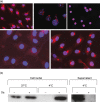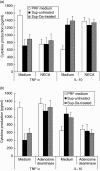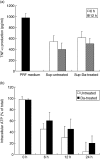High mobility group box 1 and adenosine are both released by endothelial cells during hypothermic preservation
- PMID: 18341609
- PMCID: PMC2384106
- DOI: 10.1111/j.1365-2249.2008.03643.x
High mobility group box 1 and adenosine are both released by endothelial cells during hypothermic preservation
Abstract
Hypothermic preservation of solid allografts causes profound damage of vascular endothelial cells. This, in turn, might activate innate immunity. In the present study we employed an in vitro model to study to what extent supernatants of damaged endothelial cells are able to activate innate immunity and to study the nature of these signals. The expression of high mobility group box 1 (HMGB1) and adhesion molecules on human umbilical vein endothelial cell was studied by immunofluorescence, fluorescence activated cell sorter and Western blotting. Cytokine production was performed by enzyme-linked immunosorbent assay. HMGB1 expression was lost completely in endothelial cells after hypothermic preservation. This was associated with cell damage as it occurred only in untreated endothelial cell but not in cells rendered resistant to hypothermia-mediated damage by dopamine treatment. Only supernatants from hypothermia susceptible cells up-regulated the expression of interleukin (IL)-8 and adhesion molecules in cultured endothelial cells in an HMGB1-dependent manner. In whole blood assays, both supernatants of hypothermia susceptible and resistant cells inhibited tumour necrosis factor (TNF)-alpha production concomitantly with an increased IL-10 secretion. The activity of the supernatants was already found after 6 h of hypothermic preservation, and paralleled the decrease in intracellular adenosine triphosphate (ATP) levels. Modulation of TNF-alpha and IL-10 production by these supernatants was abrogated completely by prior treatment with adenosine deaminase and was similar to the response of an A2R agonist. Our study demonstrates that both HMGB1 and adenosine are released during hypothermic preservation. While release of HMGB1 is caused by cell damage, release of adenosine seems to be related to ATP hydrolysis, occurring in both susceptible and resistant cells.
Figures






Similar articles
-
Activation of human umbilical vein endothelial cells leads to relocation and release of high-mobility group box chromosomal protein 1.Scand J Immunol. 2004 Dec;60(6):566-73. doi: 10.1111/j.0300-9475.2004.01518.x. Scand J Immunol. 2004. PMID: 15584967
-
Ketamine attenuates high mobility group box-1-induced inflammatory responses in endothelial cells.J Surg Res. 2016 Feb;200(2):593-603. doi: 10.1016/j.jss.2015.08.032. Epub 2015 Aug 28. J Surg Res. 2016. PMID: 26453003
-
Propofol inhibits the release of interleukin-6, 8 and tumor necrosis factor-α correlating with high-mobility group box 1 expression in lipopolysaccharides-stimulated RAW 264.7 cells.BMC Anesthesiol. 2017 Oct 26;17(1):148. doi: 10.1186/s12871-017-0441-0. BMC Anesthesiol. 2017. PMID: 29073894 Free PMC article.
-
Anti-inflammatory activities of oleanolic acid on HMGB1 activated HUVECs.Food Chem Toxicol. 2012 May;50(5):1288-94. doi: 10.1016/j.fct.2012.02.026. Epub 2012 Feb 22. Food Chem Toxicol. 2012. PMID: 22386814
-
Cytokine-induced adhesion molecule expression on human umbilical vein endothelial cells is not regulated by cyclic adenosine monophosphate accumulation.Life Sci. 1993;53(4):365-70. doi: 10.1016/0024-3205(93)90755-r. Life Sci. 1993. PMID: 8392131
Cited by
-
Brain hypothermic therapy dramatically decreases elevated blood concentrations of high mobility group box 1 in neonates with hypoxic-ischemic encephalopathy.Dis Markers. 2013;35(5):327-30. doi: 10.1155/2013/327604. Epub 2013 Sep 22. Dis Markers. 2013. PMID: 24191125 Free PMC article.
-
Long-Term Effects of Induced Hypothermia on Local and Systemic Inflammation - Results from a Porcine Long-Term Trauma Model.PLoS One. 2016 May 4;11(5):e0154788. doi: 10.1371/journal.pone.0154788. eCollection 2016. PLoS One. 2016. PMID: 27144532 Free PMC article.
-
Translational mini-review series on immunology of vascular disease: mechanisms of vascular inflammation and remodelling in systemic vasculitis.Clin Exp Immunol. 2009 Jun;156(3):395-404. doi: 10.1111/j.1365-2249.2009.03921.x. Epub 2009 Mar 20. Clin Exp Immunol. 2009. PMID: 19309348 Free PMC article. Review.
-
Cardiovascular Risk in Patients With Takayasu Arteritis Directly Correlates With Diastolic Dysfunction and Inflammatory Cell Infiltration in the Vessel Wall: A Clinical, ex vivo and in vitro Analysis.Front Med (Lausanne). 2022 May 16;9:863150. doi: 10.3389/fmed.2022.863150. eCollection 2022. Front Med (Lausanne). 2022. PMID: 35652080 Free PMC article.
References
-
- Maathuis MH, Leuvenink HJ, Ploeg RJ. Perspectives in organ preservation. Transplantation. 2007;83:1289–98. - PubMed
-
- Fuller BJ, Lee CY. Hypothermic perfusion preservation: the future of organ preservation revisited? Cryobiology. 2007;54:129–45. - PubMed
-
- Salahudeen AK, Haider N, May W. Cold ischemia and the reduced long-term survival of cadaveric renal allografts. Kidney Int. 2004;65:713–18. - PubMed
-
- Salahudeen AK. Consequences of cold ischemic injury of kidneys in clinical transplantation. J Invest Med. 2004;52:296–8. - PubMed
-
- Kieran NE, Rabb H. Immune responses in kidney preservation and reperfusion injury. J Invest Med. 2004;52:310–14. - PubMed
Publication types
MeSH terms
Substances
LinkOut - more resources
Full Text Sources
Research Materials

